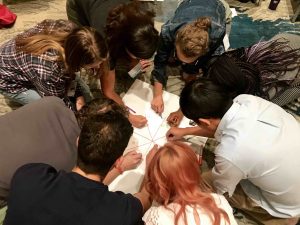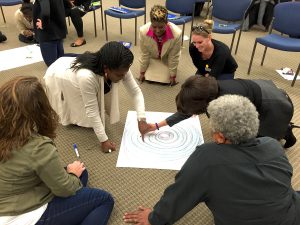Dec 07, 2018 Art and Creative Expression in Reflection
Excerpt from Tips & Tools for the Art of Experiential Group Facilitation, Second Edition:

There is great power when learners create symbols, music, words or performance to represent feelings and experiences. The very essence of art is expressing oneself. Throughout history, humans have used artistic expression to explore, understand, and share ideas and experiences.
Involvement in individual/group art activities can be a rich, reflective process for participants. Creating one’s own symbol of experience and/or collaborating on the creation of a group symbol has the potential of adding depth and breadth to the initial experience as well as providing a powerful, tangible reminder of the learning. As mentioned in chapter four, when a symbol is used or created for reflection it leaves the opportunities for meaningful interpretation of an experience wide open, enhancing emotional connection, retention, and application to real life.
Creative expression is inherently participant- centered and uses multiple pathways to learning. Artistic, reflection activities can involve a range of mediums and methods. One activity might involve a drawing that represents a personal or group experience done individually or in collaboration with others. Others could use sculpture, performance art, photography, music, or documentary—the possibilities are endless.
 • Ask the group to create a symbol that represents its experience, achievements, goals, or group norms. In chapter four, I shared a variety of artistic expression activities for exploring and defining group norms.
• Ask the group to create a symbol that represents its experience, achievements, goals, or group norms. In chapter four, I shared a variety of artistic expression activities for exploring and defining group norms.
• Schools groups and other longer-term programs can create a collage or mural of experience, using a combination of quotes and photographs from the experience (see Graffiti Wall, page 130, or this 2011 Inspired Educator Blog Post.
• Jigsaw puzzles (page, 86 ) pieces can be decorated with representations of each person’s strengths and fit together to create a quilt-like mural representing the group’s strengths and diversity.
• Scrapbooks can incorporate a variety of artistic methods. A student in one of my semester-long challenge course programs created a beautiful scrapbook depicting the group’s experience and growth. She used a combination of quotes from fellow students, photographs of their experience, drawings from group members, and found objects.

There are numerous ways to involve participants in creative writing. Groups can create a poem or song about their experience. This happened spontaneously a few years ago when a group of students came to a two-day challenge course program I was facilitating. On day two they asked to show me and the other facilitator something. They went right into a rap performance they had created about their experiences on the challenge course the previous day and their requests and expectations for the rest of the program!
Participants can journal about their experience (see upcoming post) or create a story. Group members can act as reporters for a newspaper and interview fellow participants. Audio or video documentary is another challenging art medium. As a graduate student, I worked with students to create an audio recording of a semester-long challenge course class. The compilation CD included snippets of the group’s dialogue while involved in an intense problem-solving situation and the laughter and celebration as a peer pushed her comfort zone to jump for a trapeze on the challenge course. Another student created a video documenting the group’s progress.
The process of editing down and choosing the footage to include was a masterpiece of reflective practice. Experiment with the possibilities of using performance art as reflection, and your group may go places you never expected. I’ve seen some interesting group closing activities involving short skits, living sculptures, and even a dance presentation. Look for future on articles on Self-Reflection and Mindfulness, Mementos of Experience and more in upcoming issues of the Inspired Educator Blog. Check out Chapter 7 of the Second Edition of Tips & Tools for the Art of Experiential Group Facilitation for a variety of techniques to bring learning to life through meaningful reflection.



No Comments